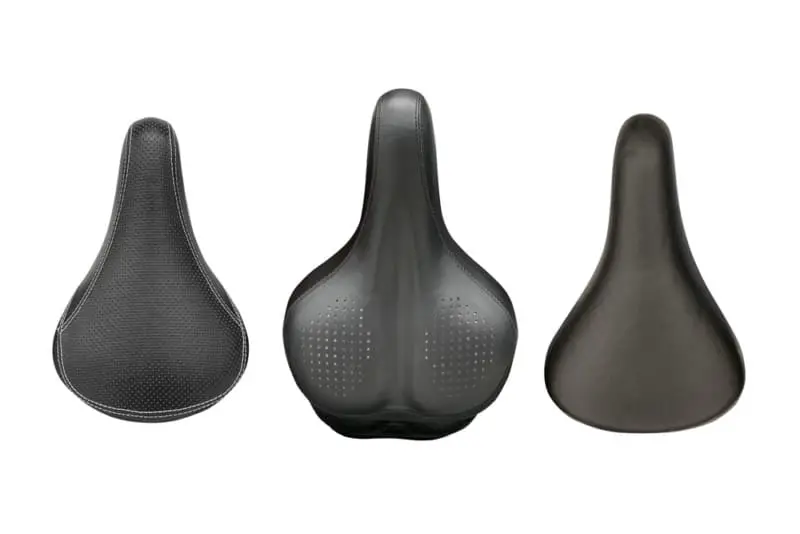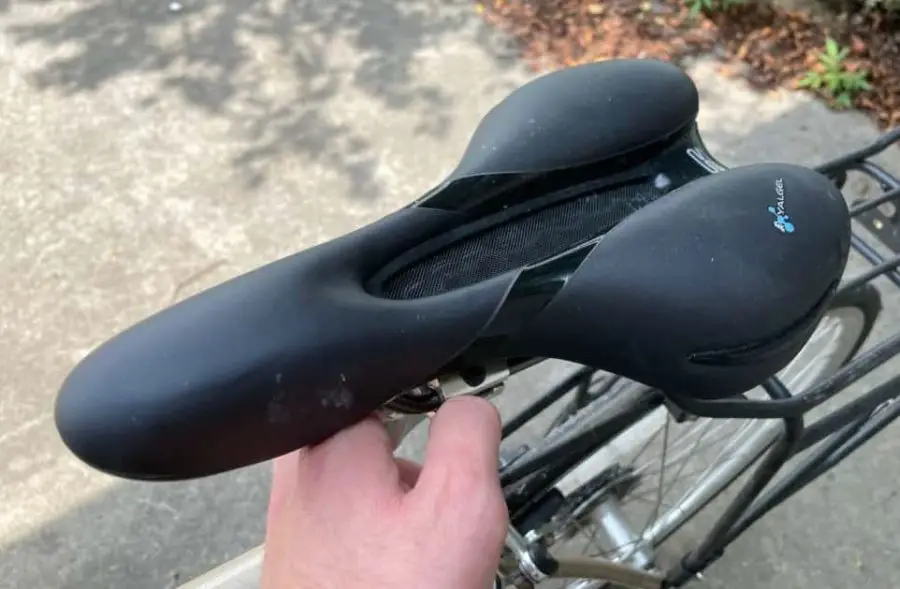Many bike seats are gender specific…but is this really necessary? For instance, could a man use a woman’s bike seat, or vice versa?
A man can use a woman’s bike seat depending on his personal anatomy. The shape and size of a male-specific seat may not be suitable for all men’s body types or riding styles, so a woman’s seat could be a better fit. The same criteria applies to women: some may find a man’s seat more comfortable or appropriate.
So what makes men’s and women’s bike seats different? And how do you determine which one is right for you? Let’s get into the details below!
Differences Between Men’s and Women’s Bike Seats
There are some distinct differences between gender-specific bike seats. These differences in seat design can be sorted into three main categories:

Shape
Men’s bike seats tend to be longer and narrower than women’s seats. This is because men’s sit bones are generally closer together than women’s, so a narrower seat will be more comfortable for most men while allowing for more freedom to pedal and move around the bike, all with less chafing…a huge plus!
Women’s seats are usually shorter and wider to accommodate women’s typically wider hips. This helps to better support the pelvic sit bones while riding. The wider seat also helps distribute weight better and put less pressure on the groin. Seat cutouts also help with this, which we’ll cover below.
Padding
The amount and location of padding can differ between a man’s and a woman’s bike seat. Different body types mean different contact pressure points.
Women’s seats tend to have more padding towards the back of the seat to prevent discomfort in the sit bones. Gel and foam seat padding serves as a buffer between the rigid seat structure and the body contact points.
Men can benefit from padding towards the nose, or front portion, of the seat to ease the pressure and friction on the soft tissues in the groin. Properly situated, this can aid in alleviating pain or numbness in the perineum: the sensitive bundle of nerves in the groin.
That being said, more padding isn’t necessarily better. Too much cushioning can lead to its own set of problems. A seat that’s too “squishy” may make it difficult to maintain a consistent riding position. If you’re moving around on the seat more than you should, this may also cause chafing, which can be seriously uncomfortable on a long ride.
Cutaways
While not all gender-specific seats feature cutaways, many do. A cutaway seat features either a channel or a hole to alleviate pressure on certain areas of the body and in the case of a hole, provide ventilation and increased air flow on those long, sweaty rides.
Women’s seats often have cutouts toward the nose of the seat to relieve pressure on the genital area. A regular seat may put pressure on sensitive nerves and restrict blood flow to the groin. A cutout removes that contact point, reducing pain and ensuring blood flow is unrestricted. Channels, or seat depressions, serve a similar purpose without the benefit of ventilation.
Men’s seats frequently feature longer cutouts that run the length of the seat to avoid pressure and friction on the perineum and prostate. While there isn’t evidence to support the long-held belief that regular bike seats will cause erectile disfunction or fertility issues, it’s still worth minimizing discomfort in this region.
Why Do Women’s Bike Seats Have Holes / Cutouts?
The main reason for holes or cutouts in women’s bike seats is comfort.
Again, anatomy plays a big role in the nuances of gender-specific saddle design. Depending on how a woman is built, she may need strategically placed space to accommodate her soft tissue for a pain-free ride.

As you can imagine, cutouts or holes also increase airflow to those nether regions to keep things drier and chafe-free. While this is true for both men’s and women’s seats, it is especially beneficial to women for keeping that area of the body in a healthy balance.
To learn more about this topic and whether you would benefit from a seat with a cutout, check out our article on the purpose of bike seat cutouts.
Are Unisex Bike Seats Any Good?
Many bike seats are in fact unisex. Some bike companies make women-specific models, but not all do. For the ones that don’t, the seats that come stock on their bikes will be designated unisex. But aftermarket seats exist for a reason: one size may not fit all.
Whether a particular unisex seat will work for either gender depends on a couple of factors:
Body Type
The most critical factor in choosing a bike saddle is a rider’s anatomy. Man or woman, size and structure of the body dictate what style is most comfortable. Since anatomical shape and size differences between men and women can vary greatly depending on the individual, a unisex seat can provide features that benefit riders of either sex.
But keep in mind unisex bike seats are designed for the “average” rider in mind. Are you a taller-than-average woman or a shorter-than-average man? Are you thinner or more robust for your gender and height? These factors will play heavily in determining if a unisex saddle will work, or if an aftermarket option will be a better fit for you.
Riding Style
Another important consideration when choosing a bike seat is the type of riding you’ll be doing most frequently, which helps to determine if a unisex seat would work well.
Are you a road rider or mountain biker? Hardcore racer or casual weekend rambler?
Women who race or are road riders may prefer a unisex seat that combines the best features of gender-specific seats, such as more padding in the rear plus a narrower nose for ease of pedaling.
Since women’s seats can also be heavier with their typically larger size and increased padding, a female racer may benefit from a lighter unisex seat that reduces the overall weight of the bike. This helps increase speed while keeping some of the added comfort of woman-centric padding placement.
Men who go on extended casual rides may reap the benefits of some of the features geared towards women’s comfort, such as extra padding, that go into a unisex design.
The amount of time spent sitting directly on the saddle and the angle of the rider’s posture while riding make all the difference in what seat will work best.
That being said, how should you go about finding the saddle that provides the best fit for your unique anatomy and riding style?
It may be a good idea to get a proper bike fitting. Visit a specialty bike shop where your specific measurements and biking requirements can be used to recommend a seat. Some shops even use pressure mapping that shows your personal contact points to determine what features your optimal seat should have. Test a few recommended models, then ride off into the sunset in comfort.
Will your perfect saddle be a gender-specific model? Maybe. But the most important thing is that you end up with a bike seat that makes riding enjoyable for you!
